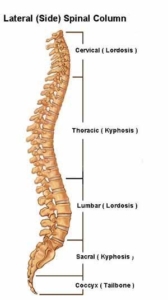
Normal and Abnormal Curvatures

Understanding the natural curvature and structure of a healthy spine will help trainers to recognize deviations and imbalances that participants may present. By offering regressions or modifications to those with spinal imbalances, trainers can help individuals feel more comfortable on equipment and more successful with exercise execution. Posture correction can also result in better, pain free movement both during class and at home.

Adapted from: https://www.memorangapp.com/flashcards/80418/Metabolic+Bone+Diseases+%2B+Osteo+Tx/
A. Normal
B. Excessive Lordosis
C. Excessive Kyphosis
D. Scoliosis
Scoliosis
Scoliosis is a common medical condition in which a person’s spinal axis has a three-dimensional deviation. Although it is a complex three-dimensional condition, on an X-ray, viewed from the rear, the spine of a patient with scoliosis often resembles an “S” or a “C” rather than a straight line. Diagnosis is confirmed with X-rays.
Kyphosis
Kyphosis refers to the abnormally excessive convex kyphotic curvature of the spine as it occurs in the thoracic and sacral regions. It can result from degenerative diseases such as arthritis, as well as developmental problems; osteoporosis with compression fractures of the vertebra; multiple myeloma; or trauma. Scheuermann’s kyphosis is the most classic form of hyperkyphosis and is the result of wedged vertebrae that develop during adolescence.
Lordosis
Lordosis refers to the normal inward lordotic curvature of the lumbar and cervical regions of the spine. Excessive curvature of the lower back is known as lumbar hyperlordosis. A major feature of lumbar hyperlordosis is a forward pelvic tilt, resulting in the pelvis resting on top of the thighs.
[Adapted from: https://www.spine-health.com/glossary/lordosis]